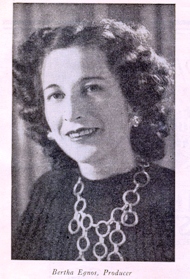Ah, the joy of a blog! My post on the movie Dingaka has provided more comments and reactions than I initially thought. Thus I was contacted by Lucille Lakier Smith, a lady who claimed to be the daughter of Bertha Egnos, the composer of Dingaka’s original soundtrack. Her mother, together with sister Gail Lakier, created South Africa’s biggest musical hit so far, ‘Ipi ‘N’ Tombi’.
My interest was immediately aroused so I decided to look up the lady in Johannesburg for an interview about her mother and her long career. South African born Lucille Lakier Smith carries on her mom’s legacy as head of Songé Music Promotions Ltd. and I want to thank her for granting me the interview and her invaluable help with providing the images from her personal archive.

interview with Lucille Lakier Smith, the daughter of the late Bertha Egnos (1912-2003) –Johannesburg 13th January 2013
“ My mother was born in 1912 in Johannesburg, she must have been 28 when she married my father Frank Lakier in 1938. Since my parents were divorced I don’t know much about their meeting, their courting and their marriage. My mother subsequently married Phil Godfrey and they were married until her passing in 2003.
My dad, Frank Lakier owned the Odin Cinema in Sophiatown, the Harlem of Johannesburg and a lot of artists performed there on stage. The cinema was also used for political meetings. From the late 40’s till the mid 50’s, the most popular style of music in the neighbourhood was Sophiatown Jive, that’s when Sophiatown was at its peak.

The Odin Cinema featured mainly movies, but they also staged a musical called ‘Sophiatown’. Nathan Dambuza Mdlele, the leader of the Manhattan Brothers, starred in this production when he was just 30 years old. The cinema was based in one of the main streets of Sophiown. In the 50’s it was a mixed area, very wonderful. It was amazing to see South Africans of all nations (Zulu, Xhosa, Sotho, etc), whites, Indians, Chinese and Jews living peacefully together, it was very, very integrated. Of course there was a lot of poverty but everybody lived in harmony. It was amazing.”
After dark, top sportsmen, entertainers and business men flocked to Sophiatown to talk, listen and dance to the newest jazz in the all night shebeens (illegal drinking dens) such as Aunt Babe’s and the 39 Steps.
“Bertha left school at the age of 12-13 and started her own jazz group. She was a child prodigy, she could do anything on a piano. After leaving school she started her own jazz group and she taught piano for a long long time. She did some recordings when she was 17, at the time of her departure from South Africa for London in 1934 when she worked for the BBC. The songs ‘Whispering’ and ‘Somebody Stole My Gal’ are the only two recordings I have. Unfortunately I broke the original shellac record.” Bertha also performed at a mammoth charity concert at the London Palladium Theatre, at which such famous artists as Gracie Fields and Sophie Tucker appeared. While overseas she studied with Reginald Forsyth, a negro pianist, who gave her a feeling for rhythm that she had received from no one else. Another outstanding player who impressed her was the American pianist Art Tatum, who, though partially blind, had a marvellous technique. These jazz pianists she describes as having the basis of the high training necessary for the playing of classical music. But most of all, these artists nurtured Bertha’s love for jazz and black music.

“In 1917, as a young child she had contracted the Spanish flue, and had landed in hospital where she was diagnosed as terminal, the doctors thought she was going to die. So my grandfather took her home. Her whole life she had trouble with her lungs, with breathing. Lots of times she was dressed warm in furs, I always thought of her as a sickly person. But she must have had the immune system of a horse since she survived the Spanish flue. She stayed in London for a few years, she couldn’t handle the cold weather in England so that’s why she came back to South Africa after eighteen months.”
In South Africa, during WW 2 Bertha formed the first All Women’s Drum and Bugle Band, she herself being the Drum Major. She went back to teaching and performing and started producing and directing Swing shows. These were charity shows at the end of the 1930’s throughout the 1940’s and the beginning of the 1950’s that were more of the English vaudeville sort of entertainment. Swing shows became very popular at the time in Johannesburg. “

So your family was very musical? “Oh yes, my mom often told me of how her whole family and friends and neighbours would congregate at their home on Banato street in Berea on a Sunday afternoon. My mom and her brother Solly would both play the piano while her other brother Mick would play the violin. In later years, my sister Gail was very close to my mother. They were always together and even worked as a team on several productions. I lived in America for 30 years and I actually got my PHD over in the States and it was only in 2000 that I came back to South Africa. In the last few years I was very close to my mum. She died in 2003. My sister passed away in 2010.”
 Bo-Jungle 1959 stage program
Bo-Jungle 1959 stage program
Bo Jungle -Jungle Capers-The Idol of My Life-Bingo Bango Ape Man-Beating of the Drums
After the series of Swing shows Bertha wrote the musical score and directed ‘Bo Jungle’ , a musical that premiered in May 1959 at the Empire Theatre in Johannesburg. The production was very well received and the success led to co-writing the music for ‘Dingaka’, an ‘all African musical’, that was staged in October 1961 at the Brooke Theatre in downtown Johannesburg. 
It made such an impact that later, in 1965, when Jamie Uys started working on his movie ‘Dingaka’, Bertha joined the team and re-wrote some of the original musical scores for the screen version. The next year she collaborated with the late Percy Baneshik and co-wrote the stage music for ‘Eureka!’.
The story is based on the early gold mining days near Barberton. The discovery of gold in the mountains of the Eastern Transvaal brought a rush of colourful personalities from every quarter of the globe. They built Eureka City in the mountains to avoid the fevers of the lowlands. The ruins of the place can be seen today – a ’ghost town’.
In Barberton a few years later, a barmaid named ‘Cockney Liz’ became famous for her exploitation of the scarcity value of women in her community. She stood up on her own bar counter to auction herself off to the highest bidder, and received bids as high as R 8000 (UK Pounds 4000 in 1968). The authors brought these two historical facts together in ‘Eureka!’ the rip-roaring town and the beautiful barmaid.
In an interview before the premiere Bertha Egnos said; ‘I have attempted to capture the gaiety and the ruthlessness of those rugged 1880’s but I have given the music a modern beat’.
The Johannesburg Civic Theatre Association brought the London West End singer Pat Lancaster to take the part of ‘Barberton Daisy’ opposite South African baritone Lawrence Folley’s portrayal of Charles ‘Dynamite’ Peters. ‘Eureka!’, the gay South African musical had its first performance at the Johannesburg Civic Theatre on 14th March 1968 under the direction of Anthony Farmer.
Bid Me A Bid -Pat Lancaster & Chorus
Dynamite & Destiny -Lawrence Folley
Music by Bertha Egnos Lyrics by Percy Baneshik Musical Director: Bob Adams Chorus Master: Donald Elliot Choreographer: Gerard Nel Musical Arrangements: Bob Adams Orchestration: Bob Adams and Jack Bassett
 But it was ‘Ipi Tombi’ that proved to be the most successful of all Bertha’s shows. The story tells the tale of a young tribesman who joins that popular drift of rural folk to the big city in search of a better life and his fortune. Instead, he encounters hardships, disappointments and a few joys. The young man is completely disillusioned and becomes homesick, and ultimately returns home at a time when his tribe is preparing for battle in the overwhelming finale…as the Warrior. It was already in 1972 that Bertha and her daughter, lyricist Gail Lakier co-wrote the songs ‘Ipi Ntombi’ and ‘Mama Tembu’s Wedding’ as the two African songs for Eartha Kitt’s tour of South Africa. Although the numbers were rejected by Kitt for being “too upbeat and rhythmic’, Egnos and Lakier were undeterred. They added another eight tracks and released an album called ‘The Warrior’ in 1973. It made a star out of singer Margaret Singana, later versions became known as ‘Ipi Tombi’ and were quite a hit all over the world.
But it was ‘Ipi Tombi’ that proved to be the most successful of all Bertha’s shows. The story tells the tale of a young tribesman who joins that popular drift of rural folk to the big city in search of a better life and his fortune. Instead, he encounters hardships, disappointments and a few joys. The young man is completely disillusioned and becomes homesick, and ultimately returns home at a time when his tribe is preparing for battle in the overwhelming finale…as the Warrior. It was already in 1972 that Bertha and her daughter, lyricist Gail Lakier co-wrote the songs ‘Ipi Ntombi’ and ‘Mama Tembu’s Wedding’ as the two African songs for Eartha Kitt’s tour of South Africa. Although the numbers were rejected by Kitt for being “too upbeat and rhythmic’, Egnos and Lakier were undeterred. They added another eight tracks and released an album called ‘The Warrior’ in 1973. It made a star out of singer Margaret Singana, later versions became known as ‘Ipi Tombi’ and were quite a hit all over the world.
When the production was staged at West End Theatres in London The Sunday Times wrote: ‘presented with verve and eclat, a technical brillance, a richness of voice in the singing, and excitement and a precision in the dancing….A riot of colour and movement. Every member of the huge cast is superb.’
Ipi Tombi feat Margaret Singana -Mama Tembu’s Wedding
‘Ipi NTombi’ which means ‘Where Are The Girls?’ swept the world like a jungle fire that couldn’t be stopped. In fact the blaze continued to spread as the musical company toured the United States. “the beat of a different drum…what excitement, vitality and sheer primitive beauty!’ –MIRROR, Las Vegas Again, working under the wings of Bertha, Gail wrote the libretto and lyrics for subsequent stage musicals including ‘Lulu-Wena’ and ‘Sikulu’. Her last collaboration with her mother and also with her sister Lucille, would be for the stage musical ‘Nijinsky –God’s Clown’ which to this date has not been staged. ‘Ipi Tombi -The New Generation’ was revived in 1997.

© Soul Safari 2013


